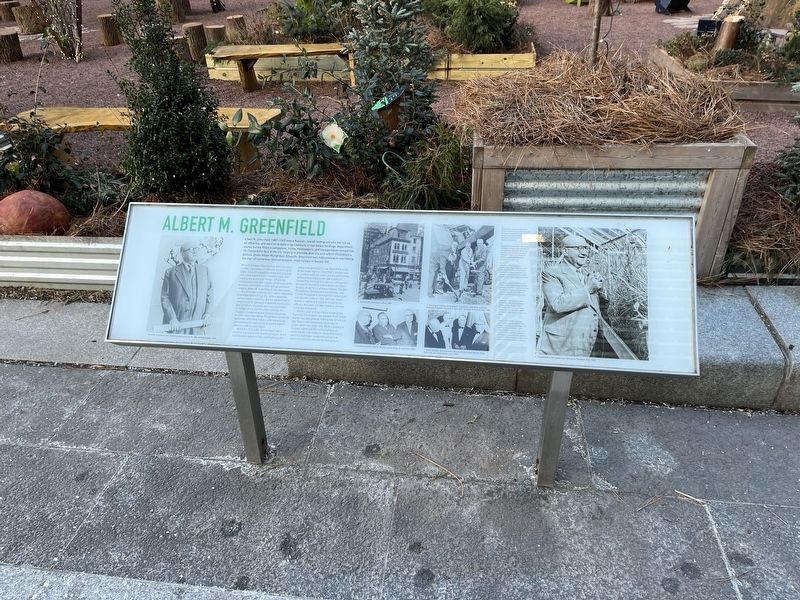William Penn Annex West in Philadelphia in Philadelphia County, Pennsylvania — The American Northeast (Mid-Atlantic)
Albert M. Greenfield
Albert M. Greenfield (1887-1967) was a Russian-Jewish immigrant who started as an office boy and went on to build a vast network of real estate holdings, department stores, banks, finance companies, hotels, newspapers, and transportation companies. He changed the face of the city, helping to promote diversity and reform Philadelphia politics. Under Mayor Richardson Dilworth, Greenfield was instrumental in overseeing the start of numerous renewal projects, most notably in Society Hill.
When Richardson Dilworth took office as mayor in 1956, many plans for renewal existed only on paper. Dilworth needed someone with practical real estate experience to translate maps and models into bricks and mortar: a Planning Commission chairman capable of harnessing the business community to work with government leaders. Albert M. Greenfield fit that description.
At a time when suburbs were rapidly expanding, Greenfield believed that city centers would died without massive overhaul. But his solution was a unique surgical approach. A detailed revitalization plan certified a thousand-acre tract southeast of Independence Hall for urban renewal, but instead of condemning a leveling everything, as other cities were doing, Philadelphia combined demolition with preservation—offering existing homeowners the opportunity to restore historic exteriors with low-cost loans.
Dilworth's first public act as mayor was a directive to proceed with Greenfield's plan. But it soon became apparent that coordinating public and private participants was beyond the scope of any public agency. Greenfield's solution was to create a nonprofit public-private partnership with business leaders who had a stake in Center City. Forming this new civic enterprise—among the first of its kind in American cities—became Greenfield's primary mission. The Old Philadelphia Development Corporation, was formed in May of 1956, with two million dollars in capital and a board including city officials, business and labor leaders, and two university presidents.
Within a year of Greenfield's arrival at the Planning Commission, the decrepit Dock Street Market was demolished, making way for Society Hill Towers and Townhouses, and historic preservation was under way. While subsequent renewal efforts placed more emphasis on retaining existing residents, Greenfield helped start the downtown residential revival that continued well into the twenty-first century.
[Captions:]
1. Greenfield was appointed chair of the City Planning Commission by Mayor Richardson Dilworth in 1956 and led the effort to transform plans and models into bricks and mortar.
2. Greenfield opened his real estate business in 1905, when he was not yet eighteen His first office was located a block south of today's Dilworth Park at the northeast corner of 15th and Chestnut Streets.
3. At a time when most new investment was occurring in the suburbs, Philadelphia focused on repositioning downtown as a center for business, education, health care, and residential living.
4. As an immigrant who was not always welcomed by established leaders, Greenfield reached across racial and religious boundaries to form alliances with African American and Catholic leaders.
5. Greenfield developed a close friendship in Philadelphia's reform mayor, Richardson Dilworth, that continued long after Dilworth left office. Tate succeeded Dilworth as mayor in 1962.
6. Greenfield had five children and twenty grandchildren. The Sugar Loaf Estate, where he lived with his wife, Elizabeth, from 1953 until his death in 1967, was sold to Chestnut Hill College in 2006, and proceeds were used to support the charitable work of the Albert M. Greenfield Foundation.
Topics. This historical marker is listed in these topic lists: Architecture • Charity & Public Work • Government & Politics • Industry & Commerce. A significant historical month for this entry is May 1956.
Location. 39° 57.131′ N, 75° 9.904′ W. Marker is in Philadelphia, Pennsylvania, in Philadelphia County. It is in William Penn Annex West. Marker is at the intersection of South Penn Square (Pennsylvania Route 611) and South 15th Street, on the left when traveling south on South Penn Square. Touch for map. Marker is at or near this postal address: 138 S 15th St, Philadelphia PA 19107, United States of America. Touch for directions.
Other nearby markers. At least 8 other markers are within walking distance of this marker. Center City Renewal (within shouting distance of this marker); 20th Century Transformation (within shouting distance of this marker); Industry & the Railroad (within shouting distance of this marker); The Plan for Philadelphia (within shouting distance of this marker); Centre Square Water Works (within shouting distance of this marker); The Building of City Hall (within shouting distance of this marker); Dilworth Park (within shouting distance of this marker); In Commemoration of the Men of Irish Birth or Lineage (within shouting distance of this marker). Touch for a list and map of all markers in Philadelphia.
Credits. This page was last revised on February 2, 2024. It was originally submitted on February 11, 2022, by Devry Becker Jones of Washington, District of Columbia. This page has been viewed 156 times since then and 30 times this year. Photo 1. submitted on February 11, 2022, by Devry Becker Jones of Washington, District of Columbia.
Editor’s want-list for this marker. A wide shot of the marker in context. • Can you help?
